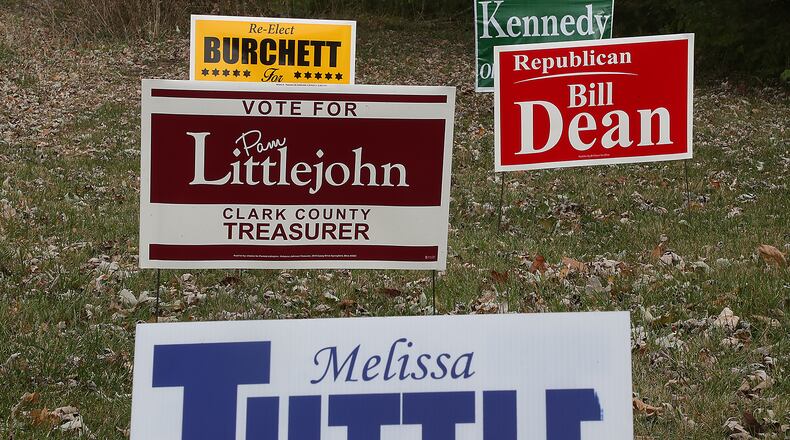Races before that were tight as well. In 2008, the county went for McCain over Obama by 1,676 votes and went for Bush over Kerry by 1,404 votes in 2004. However, in 2000, Gore edged out Bush by 324 votes.
On Tuesday, the county re-elected President Donald Trump by 14,592 votes and elected every other Republican on the ballot with more than a 30% majority over their Democratic challenger. The only Democrat on the ballot elected was Susan Brown, the county’s coroner. She faced no challenger.
To understand the county’s hard shift bellwether to red, Thomas Taylor, a history professor at Wittenberg University, said you first have to understand the demographics that make up Clark County and the Republican Party in general.
“Demographics really factor into it,” Taylor said. “Republicans tend to track white, and Clark County is 86% white, so that’s going to factor into it. There is age. The younger generation is more likely to vote for a Democrat than someone over the age of 50. Then there are other demographics - we’ve seen a decline in urban areas, like in the City of Springfield while we’ve seen non-urban, non-city areas getting larger. ”
According to U.S. Census data from July 2019, Clark County was 86.9% white, compared to the United State’s 76.3%. The county is also 19.70% over the age of 65, according to the same data.
White, non-Hispanic voters make up roughly 53% of the Republican Party as a whole, according to data from the Pew Research Center, compared to the Democratic Party, which is 40% non-white (black, Hispanic, Asain, other nonwhite racial groups).
As for age, 52% of registered voters in the United States are over the age of 50, according to Pew. Of those voters, 56% identify as Republican.
“The Republican Party would have a hard time in Clark County without those demographics," Taylor said.
Union influence
In addition to demographics, Taylor said long-term changes in manufacturing “definitely haven’t helped the Democratic Party in Clark County.”
“Union workers were really the backbone of this area, so it couldn’t have helped the party when those jobs started to leave,” Taylor said.
Chris Blizzard, president of UAW local 402, the union that represents production assembly workers and those in skilled trades at Navistar’s Springfield plant, said the UAW as a whole has decreased over the last 10 years.
However, locally those numbers have grown because the Navistar Springfield plant has increased its production over those years. In 2010, there were roughly 500 to 600 UAW local 402 members, Blizzard said. Now, they have almost 1,600.
“As far as local, we have a community action program, in which we have meetings. Basically, we sit down and look at the candidates and see which ones support working families and support labor. And then we endorse those candidates who we feel are in the best interests of our livelihoods as far as work goes here,” Blizzard said.
But even though numbers are increasing, Blizzard said they are seeing a growing disconnect between union leadership and the members they represent in terms of candidate endorsements.
“Basically what happens is they endorse candidates at the national level and put that out to the local chapters. But everybody has their own opinion on who they think is the best candidate for their livelihood. That is kind of where it’s going,” Blizzard said.
Ed Hasecke, a political science professor at Wittenberg University, said historically labor unions align more with the Democratic Party, and encourage their members to do the same.
“The unions are stronger when they can function as a group. The intent of those groups is to connect parties and identities,” Hasecke said. “When you don’t have that, that’s going to free people up to identify themselves somewhere else. That could be in religion, in a church group, or where they live.”
Warren Copeland, a Democrat who has served as Springfield’s Mayor for 25 non-consecutive years, said there was a time about six or eight years ago when “the union at Navistar was the single largest force in the Democratic Party in Clark County.”
“The area of North Springfield, where a bunch of them lived, was a very significant Democratic vote. All the trustees in those areas were Democrat, so you could see the pull that held,” Copeland said. “That held a lot of power for the party.”
Candidate recruitment
John Detrick, a Republican who served on the Board of Clark County Commissioners for nearly 20 years and is still actively involved in the Republican Party, said he agrees the shift is due in part to the shift in unions, but more so due to groundwork by the Republican Party.
Detrick said he thinks there are a lot of “good Democrats” in the county, but that the Clark County Republican Party is “very good” at finding visible candidates in the community."
Dan Harkins, chair of the Clark County Republican Party, said the party runs mostly grassroots campaigns and focuses on outreach.
“In this election, the Republicans did more door-to-door, while the Democrats focused more on phone calls and mailings,” Harkins said. “There is a much more intensive effort with the candidates to go door-to-door. Does that mean the Republican Party has a lock on the county? No.”
Harkins said he believes the Republican’s current advantage in the county doesn’t mean anyone should take it easy.
“Anyone who thinks this is a solidly red county is kidding themselves. It can change in the next election,” Harkins said.
The Springfield News-Sun reached out to the Clark County Democratic Party for this article and did not receive a response.
The Republican party in the county really started to see a shift in 2016, with local candidates “riding the coattails” of Trump, Harkins said. That election cycle, two local candidates, Deborah Burchett and Melissa Tuttle, unseated two long-serving Democrats.
Burchett beat 30-year incumbent Democrat Gene Kelly by roughly 5,000 votes to become Clark County Sheriff. Tuttle defeated long-time Clerk of Courts Rob Vincent by over 12,000 votes.
“If you look at the ballots, people who voted Republican, voted Republican all the way down,” Harkins said. “It was the same way this year. A majority of people who voted for Joe Biden voted Democrats all the way down. Same with Republicans.”
Another thing that Harkins thinks helped out the party was Trump’s visit to the Clark County Fairgrounds in 2016 before the election. Detrick agreed, saying he believes Trump’s visit helped “energize the base.”
“You can drive out in the country and see Trump flags and signs; it never used to be like that,” Detrick said.
It’s not the first time in the last 20 years a presidential hopeful has visited the county. In 2012, Obama visited Springfield just a week before election day.
Hasecke said historically presidential rallies work at drumming up turnout and “energize the local effort to get out to vote.”
“When a candidate comes, there is a level of excitement in a room full of people who all support and believe in the same things you do. It’s the same idea as going to concrete with people who know your favorite songs,” Hasecke said. “There is a certain level of celebrity it brings, and Trump brings that power even more.”
Presidential elections and votes in Clark County:
2020: Trump= 38,217 Biden= 23,625
2016: Trump= 35,205, Clinton= 23,328
2012: Rommey= 31,820, Obama= 31,297
2008: McCain= 33,634, Obama= 31,958
2004: Bush= 34,938, Kerry= 33,534
2000: Gore= 27,984, Bush= 27,660
Source: Clark County Board of Elections
Unmatched covergage:
The Springfield News-Sun has provided in-depth coverage of the 2020 General Election. To see all of Tuesday night’s results, visit springfieldnewssun.com.
About the Author


